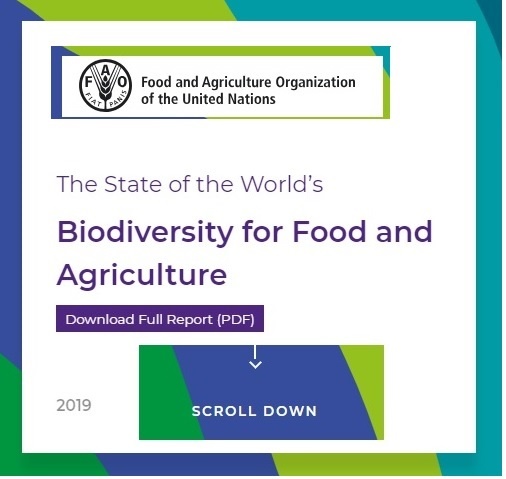The State of the World’s Biodiversity for Food and Agriculture (FAO, 2019) based on DATA

In February 2019, the Food and Agriculture Organization of the United Nations (FAO) released its new report on Biodiversity for Food and Agriculture entitled 'The State of the World’s Biodiversity for Food and Agriculture' (SoW-BFA).

Based on data provided by 91 countries and 27 international organizations, analysis of global literature and datasets, and contributions from over 175 authors and reviewers, the SoW-BFA report provides an assessment of biodiversity for food and agriculture (BFA) and its management worldwide. |
According to AGROVOC multilingual thesaurus, BIODIVERSITY is...
... "the variability among living organisms from all sources including, inter alia, terrestrial, marine and other aquatic ecosystems and the ecological complexes of which they are part; this includes diversity within species, between species and of ecosystems. Diversity indices are measures of richness (the number of species in a system); and to some extent, evenness (variances of species’ local abundance). They are therefore indifferent to species substitutions which may, however, reflect ecosystem stresses (such as those due to high fishing intensity)" (browse AGROVOC in SKOSMOS to see related definitions).
THE ROLE OF BIODIVERSITY FOR FOOD AND AGRICULTURE (BFA)
The SoW-BFA report underlines that biodiversity protection is indispensable for the sustainability of agriculture & food security and in particular it describes:
|
|
|
|
|
|
|
Approaches to monitoring the status and trends of BFA vary across sectors and across categories of biodiversity, depending, inter alia, on what data are considered useful for management purposes, how difficult such data are to collect, and the extent to which the relevant resources and capacity are available.
Risk categorization can be based on more or less complicated methods, depending on the availability of data on population sizes, structures and trends, geographical distributions, threats and other factors. If population data are available, it is also possible to calculate statistics based on the distribution of the individual organisms within a population across species (or breeds, varieties or other categories) and to monitor how these change over time.
ALL OTHERS MUST BRING DATA..? AVAILABLE DATA OFTEN PROVIDE ONLY A SNAPSHOT ... |
Even in developed regions, where the population trends of many species are well monitored and there are numerous ongoing research projects on the links between biodiversity and food and agriculture, available data often provide only a snapshot of the status of individual species (or groups of species) in particular production systems, habitats or geographical areas.
While it is clear that many components of BFA are declining, lack of data often constrains the planning and prioritization of effective remedial measures. This means also that the broad scope and innovative perspective of the BFA assessment presents challenges in terms of data collection and analysis at all levels.
Since the Commission recognized that findings would be incomplete in a number of areas, it requested that gaps (that exist across all categories of BFA) in knowledge be assessed and highlighted in the SoW-BFA report. To this end, the SoW-BFA has drawn on a range of the...
... DATA SOURCES INCLUDING: |
- the Domestic Animal Diversity Information System
- the World Information and Early Warning System on Plant Genetic Resources for Food and Agriculture
- the International Union for Conservation of Nature’s Red List of Threatened Species
- the International Disaster Database EM-DAT
- DIAS Database on Introductions of Aquatic Species
- EODHaM Earth Observation Data for Habitat Monitoring
- World Bank Open Data
- Organisation for Economic Co-operation and Development (OECD) Data
- GEMStat Global Water Quality Database and Information System
- FAOSTAT FAO Statistical Database
- the FAO/INFOODS International Network of Food Data Systems/Food Composition database for biodiversity
FAO is also ‘custodian’ UN agency for 21 indicators under Sustainable Development Goals 2, 5, 6, 12, 14 and 15, and a ‘contributing’ agency for four more. Many of these indicators directly or indirectly measure components of BFA. Data for Indicators 2.5.1 and 2.5.2 are compiled by FAO through the World Information and Early Warning System on Plant Genetic Resources for Food and Agriculture (WIEWS) and the Domestic Animal Diversity Information System (DAD-IS), both of which are managed under the guidance of the Commission on Genetic Resources for Food and Agriculture Biodiversity for food and agriculture |
In this way, the report has:
- complemented the sectoral assessments and filled gaps in terms of scope and focus by paying particular attention to the interface between managed and unmanaged biodiversity, cross-sectoral interactions and the roles of components of BFA in the supply of supporting and regulating ecosystem services;
- highlighted that methods for recording, storing and analysing data on changes in the status of species and habitats in and around production systems, and making them accessible to those that need them should be improved.
Learn more about what and how data were analyzed by accessing and reading |
RELATED:
- The State of the World’s Aquatic Genetic Resources for Food and Agriculture (FAO, forthcoming) focuses on cultured species and their wild relatives, within national jurisdiction. It draws on 92 country reports and five specially commissioned thematic background studies
- The Biodiversity for Food and Nutrition (BFN) Project
- Much of the BFN project’s experience in promoting the conservation and sustainable use of biodiversity for food and nutrition and mainstreaming it into different sectors is captured in a FREE ONLINE COURSE: MAINSTREAMING BIODIVERSITY FOR FOOD AND NUTRITION. Benefits for agriculture, health and livelihoods
- GO FAIR Processes & Implementation Networks (INs). Towards Food Systems IN
- Discover VEST/AgroPortal AgriSemantics map of Data Standards, FAIRSharing, RDA IGAD ‘Landscaping the Use of Semantics to Enhance the Interoperability of Agricultural Data'… and keep coping with FAIRifying challenge!
- AGROVOC: BACKBONE to INTEGRATE & DISCOVER interoperable DATA
- Discover AGROVOC multilingual Thesaurus of the Food and Agriculture Organization of the UN (FAO)... in Numbers!
- Discover AGRIS: International System for AGRICULTURAL SCIENCE and TECHNOLOGY... in Numbers!
- You can now get Full-Text content via Research4Life/AGORA (Access to Global Online Research in Agriculture) enhanced with new Country-Specific Search in Summon!
Towards FARMER-led RESEARCH: a GUIDE to working together with Farmers in Research
THE RDA IGAD CAPACITY DEVELOPMENT FOR AGRICULTURE DATA WG IN ACTION
Welcome to GODAN Action Open Data Management in Agriculture and Nutrition free Online Course
To keep up-to-date with AIMS news, please, Sign up for AIMS news, follow @AIMS_Community on Twitter. And, thanks again for your interest!

